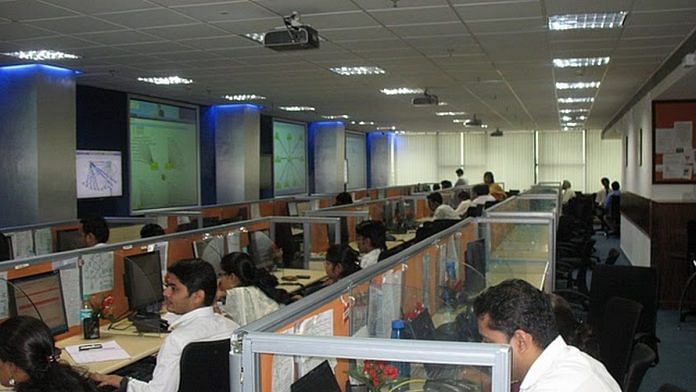New Delhi: India’s export performance presents an underwhelming picture, but there’s one bright spot: services.
According to Reserve Bank of India (RBI) data, India’s export of services reached an all-time high of $273.57 billion as of November last year — that’s 17.03 per cent more than the value of services exported in all the 12 months of 2021, despite the looming threat of a global recession.
It’s all the more impressive considering that 10 years ago, in 2012, India exported $140 billion worth of services. Rising at an annual average growth rate of 6.9 per cent, this number nearly doubled within the first 11 months of 2022.
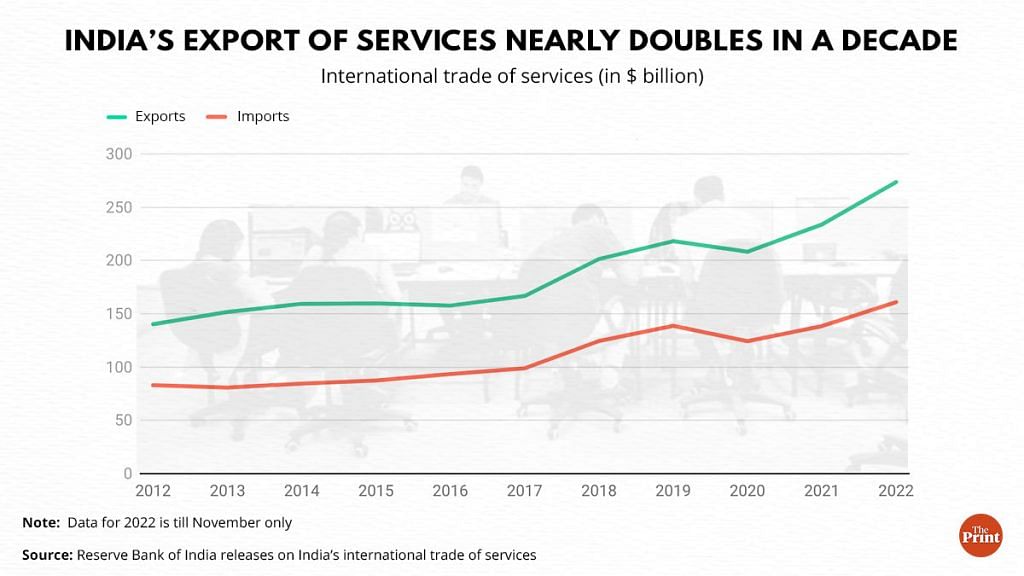
Analysis of service sector data in India suggests that the increase in exports can be largely attributed to thriving fields like information technology (IT) and telecom services, which are also witnessing fast growth within the country.
According to marketing intelligence firm International Data Corporation’s Worldwide Semi-annual Services Tracker, India’s IT and business services market will grow at a compound annual growth rate (CAGR) of 8.3 per cent between 2021 and 2026.
Experts have credited this to a highly skilled workforce, lower costs of services, and a more liberalised policy framework.
“Trade theory suggests that a country exports a commodity or service which intensively uses resources that are in plenty in the country. India’s endowment of human capital, including analytical skills and better spoken English as compared to the Chinese, helped the country to become competitive in IT and BPO services in the emerging economies since the starting of India’s globalisation process,” said Rudrani Bhattacharya, associate professor at the National Institute of Public Finance and Policy (NIPFP), an autonomous research institute under the Union Finance Ministry.
Also read: Excess imports, sluggish exports — what makes India’s current account deficit more challenging
Trade surplus for services
When it comes to India’s current account balance, or the difference between the value of a country’s imports and exports, the services sector generally registers a surplus and merchandise a deficit.
While India’s imports of services have grown, from $83 billion in 2012 to $160.93 billion in 2022, this value is still significantly below the exports, resulting in a trade surplus — which means more dollars are coming in India for services it renders than what goes out in spending.
In the first eleven months of 2022, India’s international trade of services recorded a surplus of $112.6 billion, in sharp contrast to the huge deficit of $250 billion for tangible goods as of November 2022. The surplus of exports in services helps in cushioning the overall current account deficit to a great deal.
IT and telecom big drivers
‘Other business services’ and ‘telecommunications, computer and information services’ are the two sectors that account for about two-thirds of India’s services exports, according to data (available until 2021) from Trade Map, which is a portal developed by the International Trade Centre (ITC), a joint agency of the United Nations and World Trade Organisation.
The remainder of the country’s services exports comes under sectors like transportation, travel, recreation, insurance, construction, charges for using intellectual property rights, among others.
The sector where export has grown the fastest in the past decade is ‘other business services’, under the ambit of which come professional and management consulting, research and development, as well as services rendered by business process outsourcing companies (BPO) and IT firms.
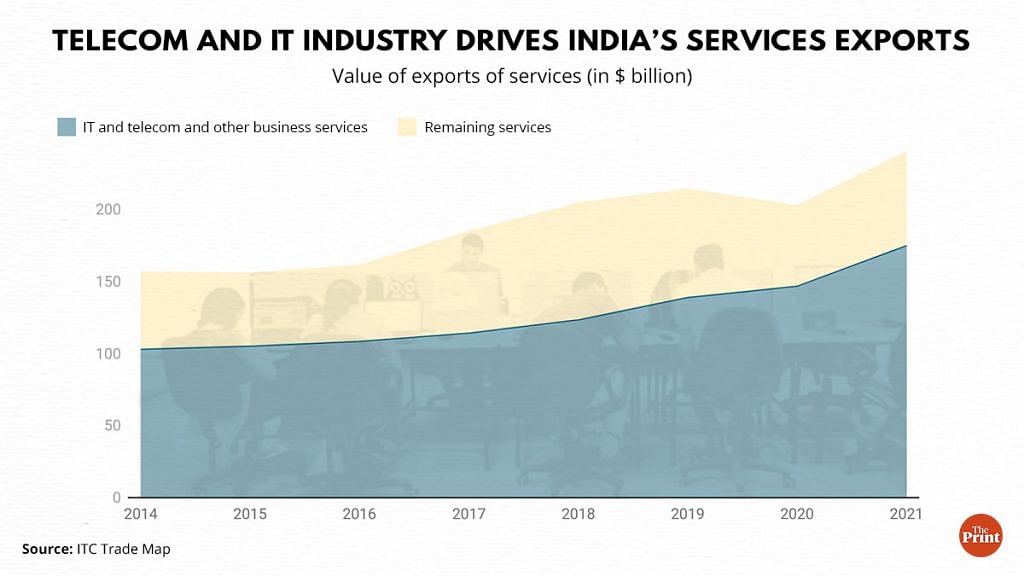
In 2011, this sector exported $38.55 billion worth of services, but by 2021, the value was $92.3 billion, recording an annual average growth rate of about 9.2 per cent.
The non-IT/non-BPO telecom sector also grew fast. In 2011, this sector exported $47.11 billion worth of services, which by 2021 had reached $82.03 billion. That’s an average annual growth rate of around 5.7 per cent.
Transportation services too have increased from $17.70 billion to $29.34 billion in the same 10-year span, which is an average annual growth rateof 5.18 per cent.
Healthy domestic growth
The value addition of the service sector in India’s total output (or Gross Value Addition) is above 55 per cent, according to government estimates for 2022-23 released Friday, it was not devastatingly impacted by the pandemic.
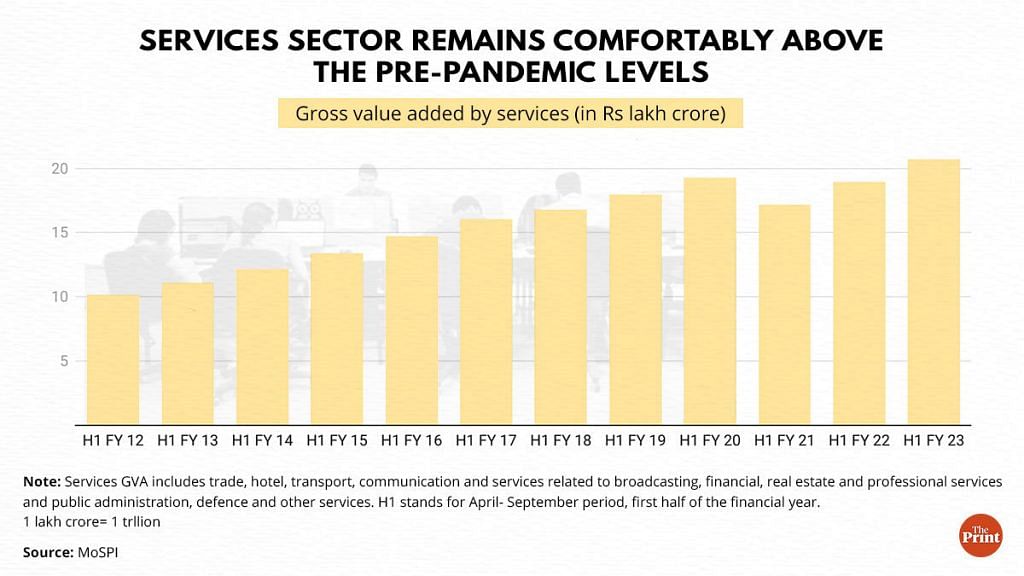
In fact, the sector is only expected to grow, according to the December 2022 round of the S&P Global India Purchasing Managers’ Index (PMI) for Services, which is derived monthly from surveys of senior executives at private sector companies.
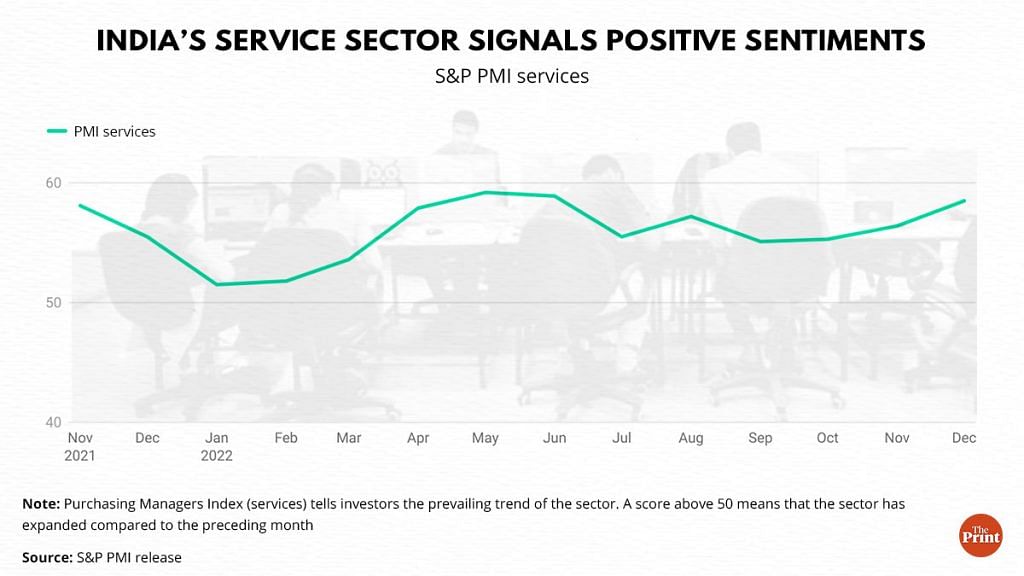
In December this year, India’s PMI score, which measures the trend or direction of business activity in the sector, reached an 11-year high of 58.5, indicating a high expansionary trend.
“As long as the world is safe from a new variant of Covid-19 and no new trade disruption takes place, the demand for services is likely to go up — and mostly driven by domestic demand,” Bhattacharya said.
She conceded that while in the short-term the demand in the international market for services may be affected by recession fears abroad, the long-term outlook remained positive.
“In the long run, exports from the services sector look sustainable owing to competitive advantage,” Bhattacharya concluded.
(Edited by Asavari Singh)
Also read: Despite border tensions & calls for boycott, imports of Chinese goods up 44% in a year



